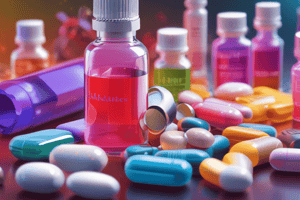Podcast
Questions and Answers
What is the primary objective of dietary therapy in non-pharmacological treatment?
What is the primary objective of dietary therapy in non-pharmacological treatment?
- To encourage physical activity of high intensity
- To achieve a desirable body weight (correct)
- To increase intake of total fat, saturated fat, and cholesterol
- To promote smoking cessation
What is the main effect of fish oil supplementation?
What is the main effect of fish oil supplementation?
- Has no effect on lipid levels
- Elevates triglycerides and VLDL-C levels (correct)
- Reduces total and LDL cholesterol levels
- Decreases bile acid pool size
How do Bile Acid Resins (BARs) lower LDL levels?
How do Bile Acid Resins (BARs) lower LDL levels?
- By decreasing bile acid synthesis
- By stimulating hepatic synthesis of cholesterol
- By increasing the number of LDL-receptors on hepatocyte membranes (correct)
- By elevating the bile acid pool size
What are the common adverse effects of Bile Acid Resins (BARs)?
What are the common adverse effects of Bile Acid Resins (BARs)?
Which non-pharmacological treatment is recommended to assist patients with smoking cessation and control of hypertension?
Which non-pharmacological treatment is recommended to assist patients with smoking cessation and control of hypertension?
What is the recommended duration of moderate intensity physical activity for overweight patients?
What is the recommended duration of moderate intensity physical activity for overweight patients?
What is the primary objective of fish oil supplementation?
What is the primary objective of fish oil supplementation?
How do Bile Acid Resins (BARs) lower LDL levels?
How do Bile Acid Resins (BARs) lower LDL levels?
What are the common adverse effects of Bile Acid Resins (BARs)?
What are the common adverse effects of Bile Acid Resins (BARs)?
What are the objectives of dietary therapy in non-pharmacological treatment?
What are the objectives of dietary therapy in non-pharmacological treatment?
Substance P binds to the subtype neurokinin-1 (NK1 ) ______
Substance P binds to the subtype neurokinin-1 (NK1 ) ______
NK1 receptor antagonists are now available for use as an adjunct to dexamethasone and a 5HT3 antagonist in preventing nausea and ______ associated with moderately and highly emetogenic chemotherapy
NK1 receptor antagonists are now available for use as an adjunct to dexamethasone and a 5HT3 antagonist in preventing nausea and ______ associated with moderately and highly emetogenic chemotherapy
A newer NK1 receptor antagonist netupitant is now available as a mixed-dose combination with palonosetron (a 5HT3 antagonist) known as NEPA for the prevention of acute and delayed nausea and ______ associated with moderately emetogenic chemotherapy and highly emetogenic cisplatin-based chemotherapy
A newer NK1 receptor antagonist netupitant is now available as a mixed-dose combination with palonosetron (a 5HT3 antagonist) known as NEPA for the prevention of acute and delayed nausea and ______ associated with moderately emetogenic chemotherapy and highly emetogenic cisplatin-based chemotherapy
NK1 receptor antagonists are inhibitors, and sometimes inducers, of cytochrome P450 (CYP3A4) and inducers of ______
NK1 receptor antagonists are inhibitors, and sometimes inducers, of cytochrome P450 (CYP3A4) and inducers of ______
Therefore, potential drug interactions with chemotherapeutic agents and other concomitantly administered agents, for example, ______, may occur
Therefore, potential drug interactions with chemotherapeutic agents and other concomitantly administered agents, for example, ______, may occur
Flashcards are hidden until you start studying




